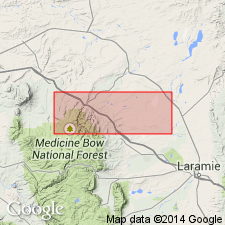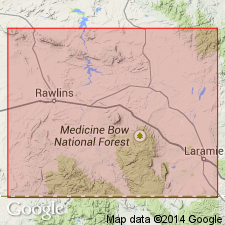
- Usage in publication:
-
- Dutton Creek Formation*
- Modifications:
-
- Named
- Dominant lithology:
-
- Conglomerate
- Sandstone
- Siltstone
- Mudstone
- Shale
- AAPG geologic province:
-
- Green River basin
Summary:
Named for exposures measured near where Dutton Creek crosses Albany-Carbon Co. boundary in secs 32 and 33, T19N, R77W, WY in Greater Green River basin (the type area). Consists of coarse-grained, locally conglomeratic sandstone, interbedded greenish-gray or olive mudstone, dark-gray, silty, micaceous, carbonaceous shale, gray fine- to medium-grained sandstone, conglomerate, and coal. Conglomerate lenses common at base of formation. Is markedly finer grained away from Medicine Bow Mountains. Sandstones are poorly sorted, generally friable, with local zones that have good cementation. Green hornblende is a prominent constituent in the sandstone. Precambrian amphibolites in the Medicine Bows were probably the source for most of the hornblende. Is estimated to be 200 to 500 ft thick. Overlies Foote Creek Formation (new); underlies Wind River Formation. Assigned a late Paleocene age on basis of fossil pollen. Is a stream deposit laid down on the channeled upper surface of Foote Creek. Replaces use of Hanna Formation in Carbon and Laramie basins, WY.
Source: GNU records (USGS DDS-6; Denver GNULEX).

- Usage in publication:
-
- Dutton Creek Formation†
- Modifications:
-
- Abandoned
- AAPG geologic province:
-
- Green River basin
- Wind River basin
Summary:
Abandoned as a formal name. Represents one of the many coarse-grained tongues of Hanna Formation, a name reinstated in the Greater Green River and Wind River basins, WY.
Source: GNU records (USGS DDS-6; Denver GNULEX).
For more information, please contact Nancy Stamm, Geologic Names Committee Secretary.
Asterisk (*) indicates published by U.S. Geological Survey authors.
"No current usage" (†) implies that a name has been abandoned or has fallen into disuse. Former usage and, if known, replacement name given in parentheses ( ).
Slash (/) indicates name conflicts with nomenclatural guidelines (CSN, 1933; ACSN, 1961, 1970; NACSN, 1983, 2005, 2021). May be explained within brackets ([ ]).

